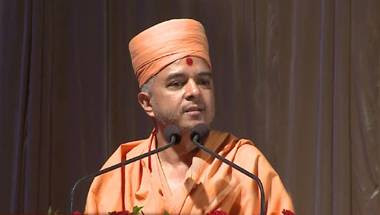In this age
of a million outrages a day - a news
dispatch from Thirssur, Kerala reported ''Woman Translator of Dr Abdul Kalam
denied seat on dais" http://timesofindia.indiatimes.com/city/thiruvananthapuram/Unholy-diktat-Woman-writer-denied-seat-on-dais/articleshow/49124567.cms).
It transpired that the chief guest - the Head of the local Swaminarayan Ashram
- had requested that no woman be present on the stage - as per the injunction
of his spiritual order to avoid close proximity with women. This was considered
''anti-women'' by the lady translator (who was obviously keen - perhaps,
rightfully so - to share the flashlights of the cameras) and she was able to mobilize
support of various Left organizations who stormed the venue and occupied the
stage. Finally, the publishers decided to keep the Swami himself away from the
function and conducted the ceremony with another chief guest.
The question
is not about the translator's ''entitlement'' to be present on stage - which is
an issue she ought to have sorted out with the publishers - but that of linking
it to the request of a monastic person, who happened to be also the prime
invitee, giving it the twist of ''anti-woman attitude'' and making it a
full-blown controversy with rent-a-cause protesters. It is surely the
prerogative of organizers to decide on a Chief-Guest. By any measure, the
choice of chief guest was logical and
appropriate considering the book itself was about the 'spiritual experiences'
of Dr Kalam with the current Chief of the Swaminarayan sect. It is also good
form all across (not just a part of Indian or ''Hindu'' tradition) to respect
the preferences and sensitivities (sometimes - even idiosyncrasies) of the
principal dignitary of a function.
The idea of
''Brahmacharya'' in Hinduism doesn't merely mean celibacy and abstinence. It starts
at the core - from eschewing carnal thoughts or avoiding all things that might
trigger such impulses - which obviously includes association with members of
the opposite sex. It is naive to assume that - just by donning a saffron cloth
(or, for that matter white cassocks - as we also know) one can automatically
rise above sexual desires. It can only
be an outcome of deep, life-long ''Sadhana''. In fact - ancient spiritual masters
and later-day psychologists both understood ''spiritual progression'' is like
climbing a slippery pole and those pursuing the difficult path are often more
susceptible to falls. Hence, our rishis and sages (of, practically all cultures
and religion) prescribed - need for safeguards and strict rules for monastic
life.
Let's first
accept - to embrace a certain religious denomination is a personal choice - as
indeed is decision to be a follower, disciple or devotee of that order. From a
layman's perspective - it may be argued - such restrictions on segregation of
sexes is not practical in this day and age. Therein lies the rub. Even without going back
to our mythologies - we know of many instances in recent times when the sexual
code was breached by spiritual ''Gurus'' of standing - including some famous
ones even now languishing in jail. And, one must hasten to add this is not
restricted to Hindu sects alone even in ''God's own country'' Kerala.
Therefore,
it is not without reason that many ''conservative'' religious orders -
including a relatively modern and progressive one like the Ramakrishna Mission
- impose stringent restrictions on their members. That brings me to a parable
from the Gospel of Sri Ramakrishna. He narrated, once four young novitiate
monks sat in meditation in the woods on the periphery of a village. Of them, 3
were celibate and one had been married briefly in his early youth. After
sometime - a young girl was passing by on her way to fetch water from the river.
While the first three remained undisturbed, immersed in meditation - the fourth
- instinctively sensed the feminine presence even from a distance and tried to
furtively catch a glimpse of her from one corner of his eye. The point being
'sanskars' (or sensual residues as it were) are not easy to cure.
So it could
be - far from meaning it as an 'affront' to
a woman - the Swaminarayan Saint - may have considered it traditional
monastic propriety. If we had more of Swami Bhrahmaviharidasjis than Asarams and Nityanands - there
would probably be fewer instances of sexual exploitation under the garb of
spiritual guidance.
Article first published in @DailyO_ (Read Comments on the site)

No comments:
Post a Comment